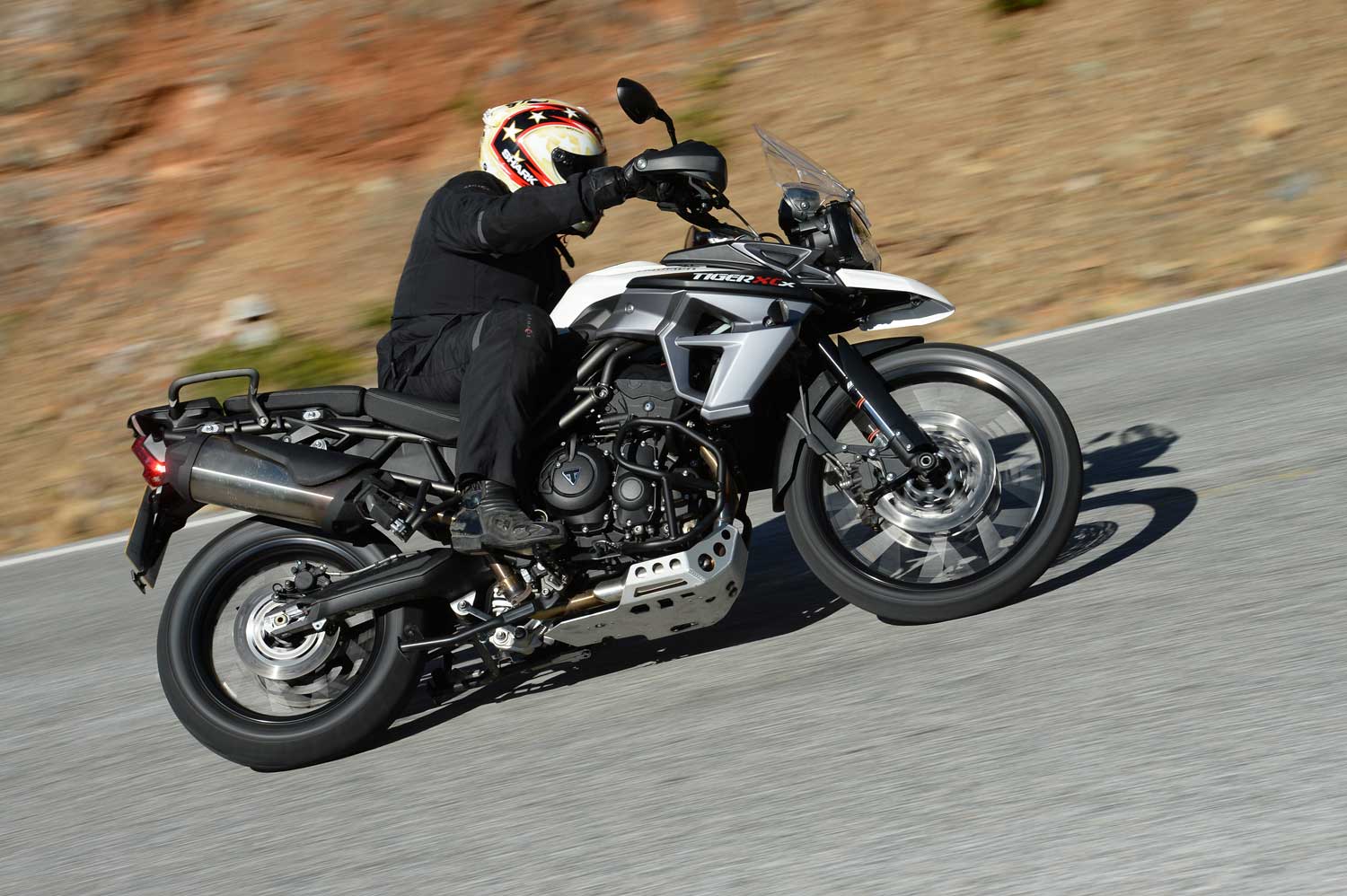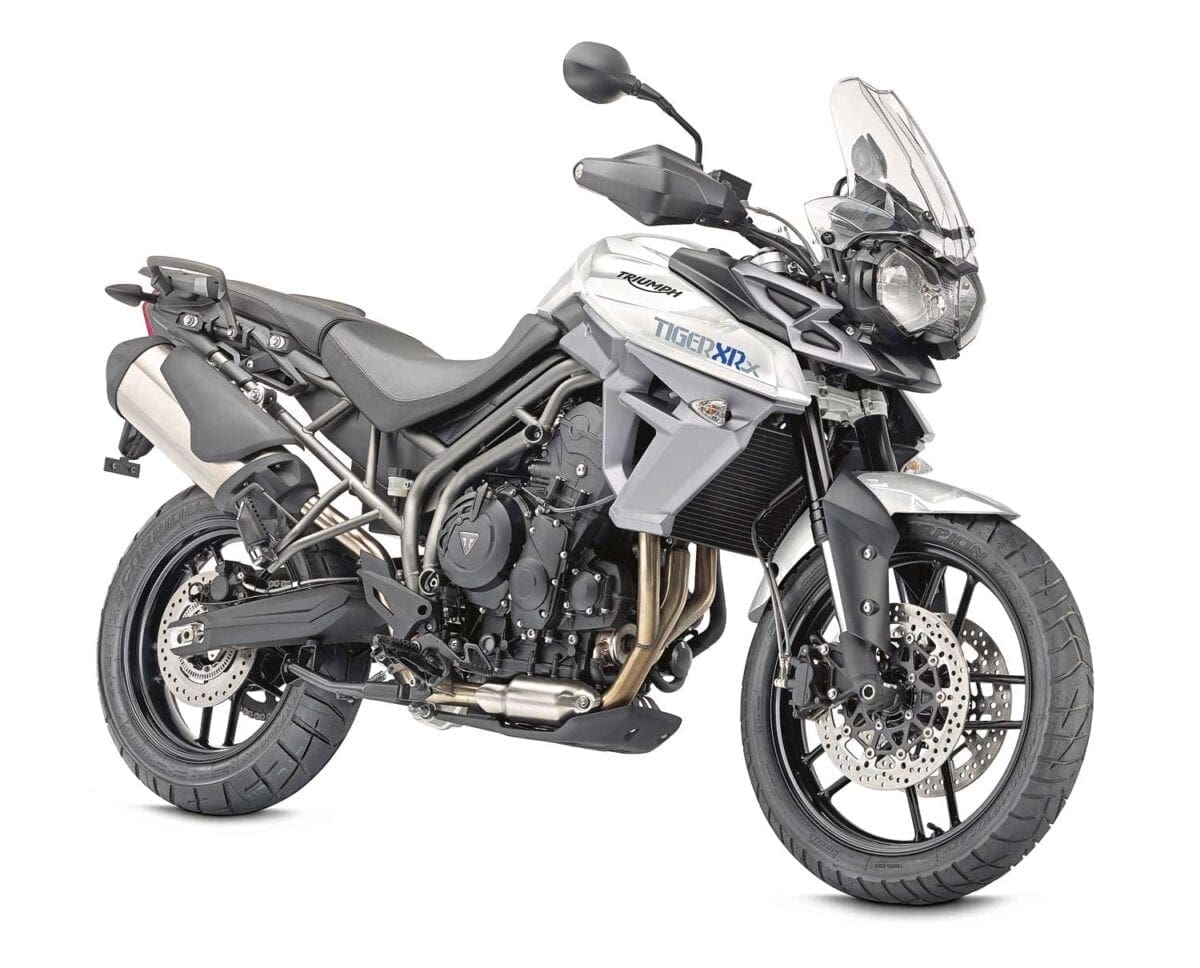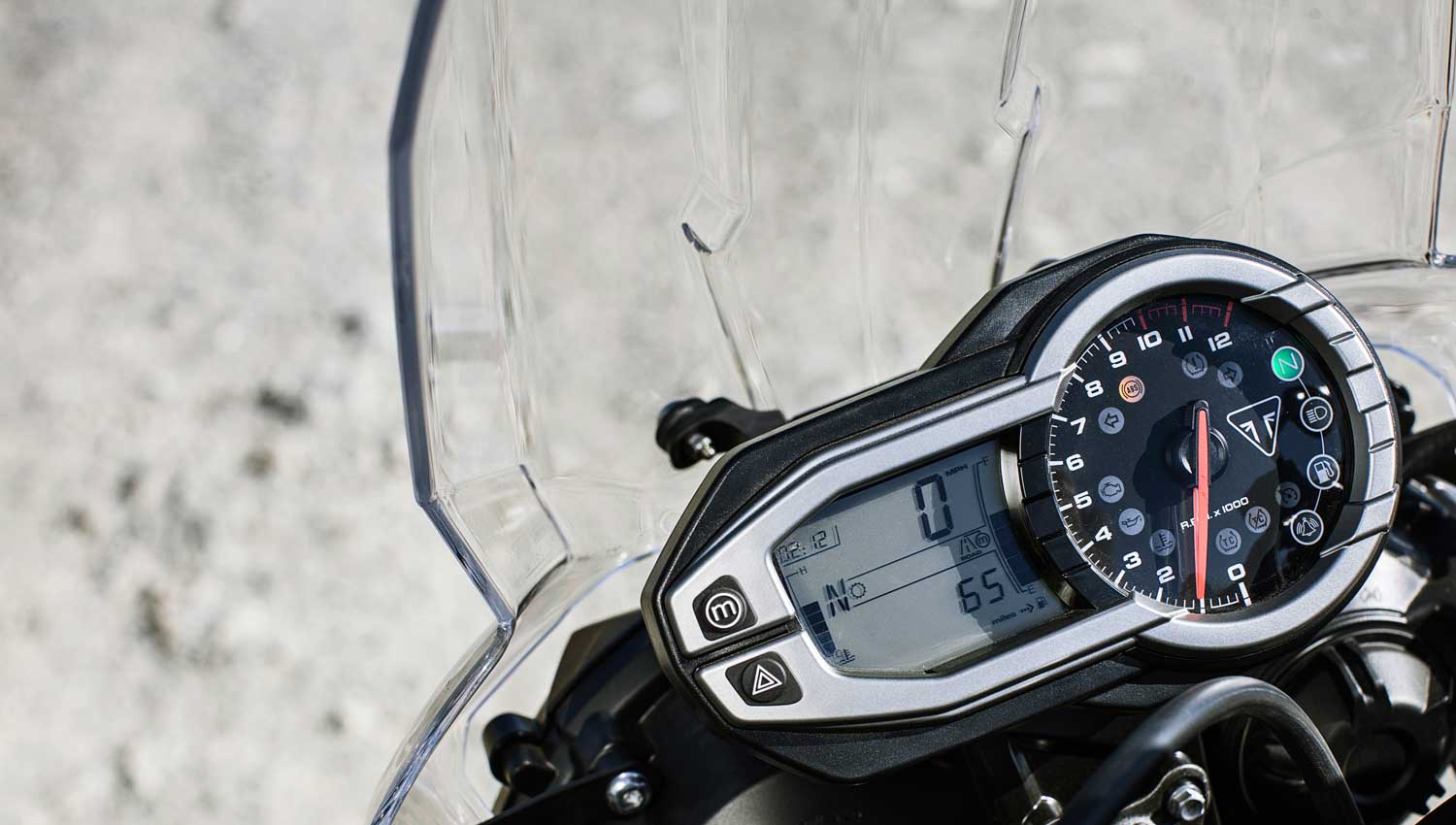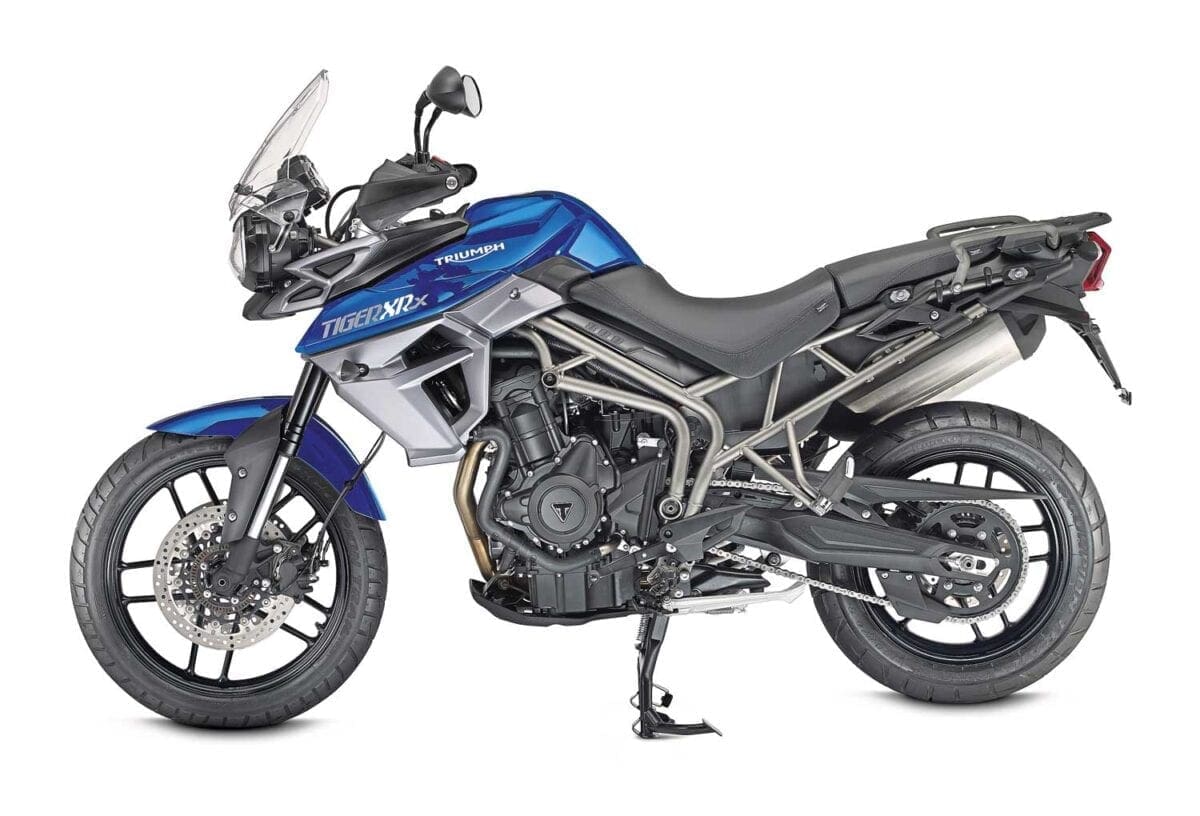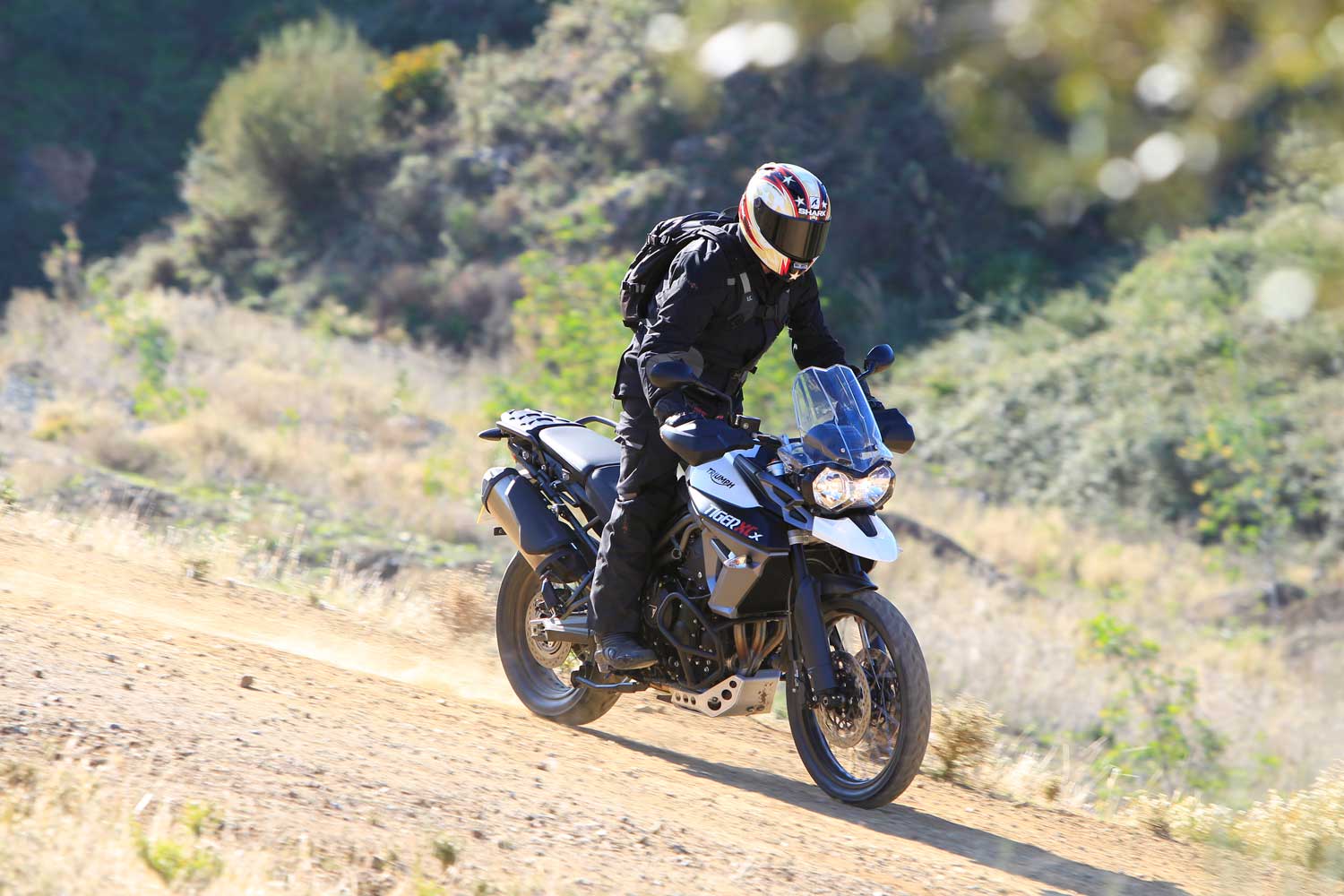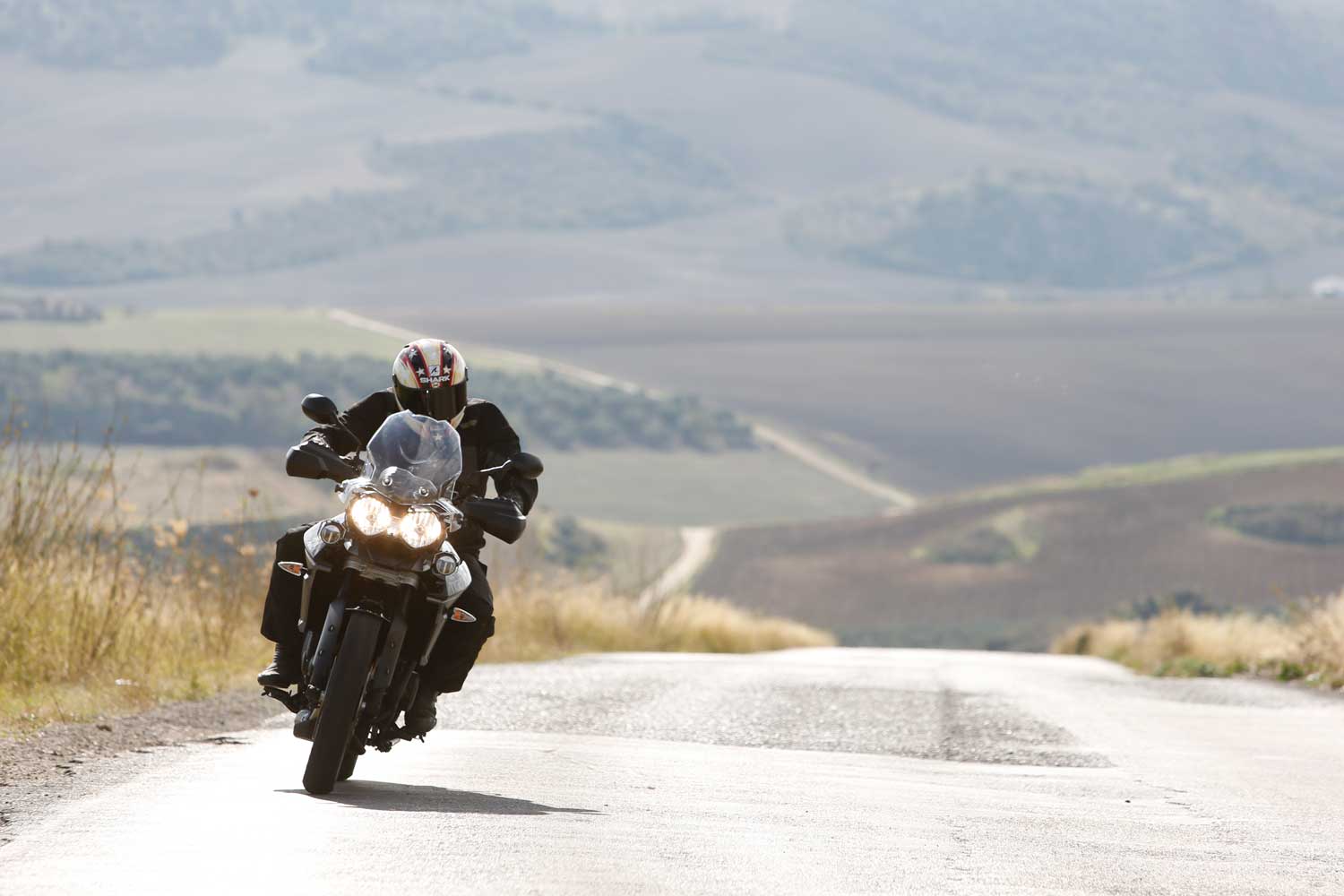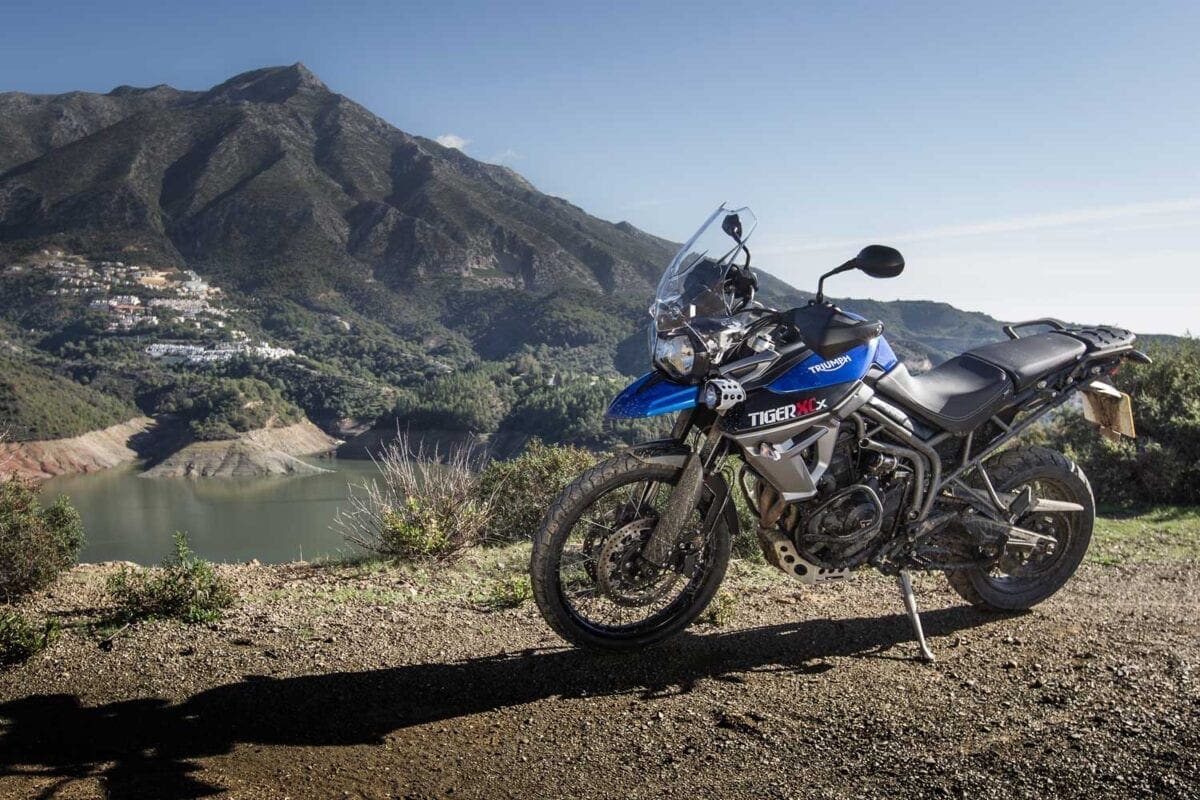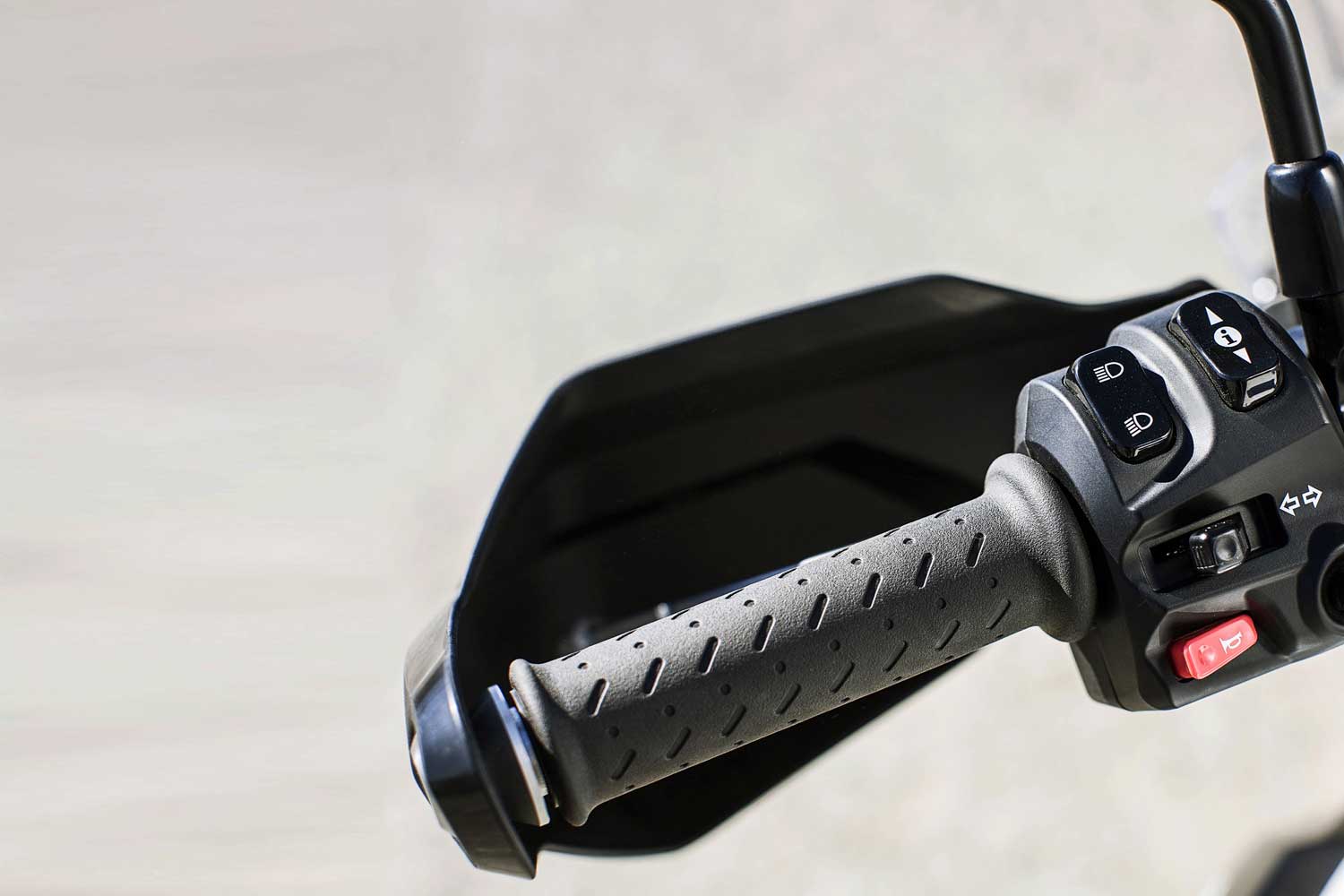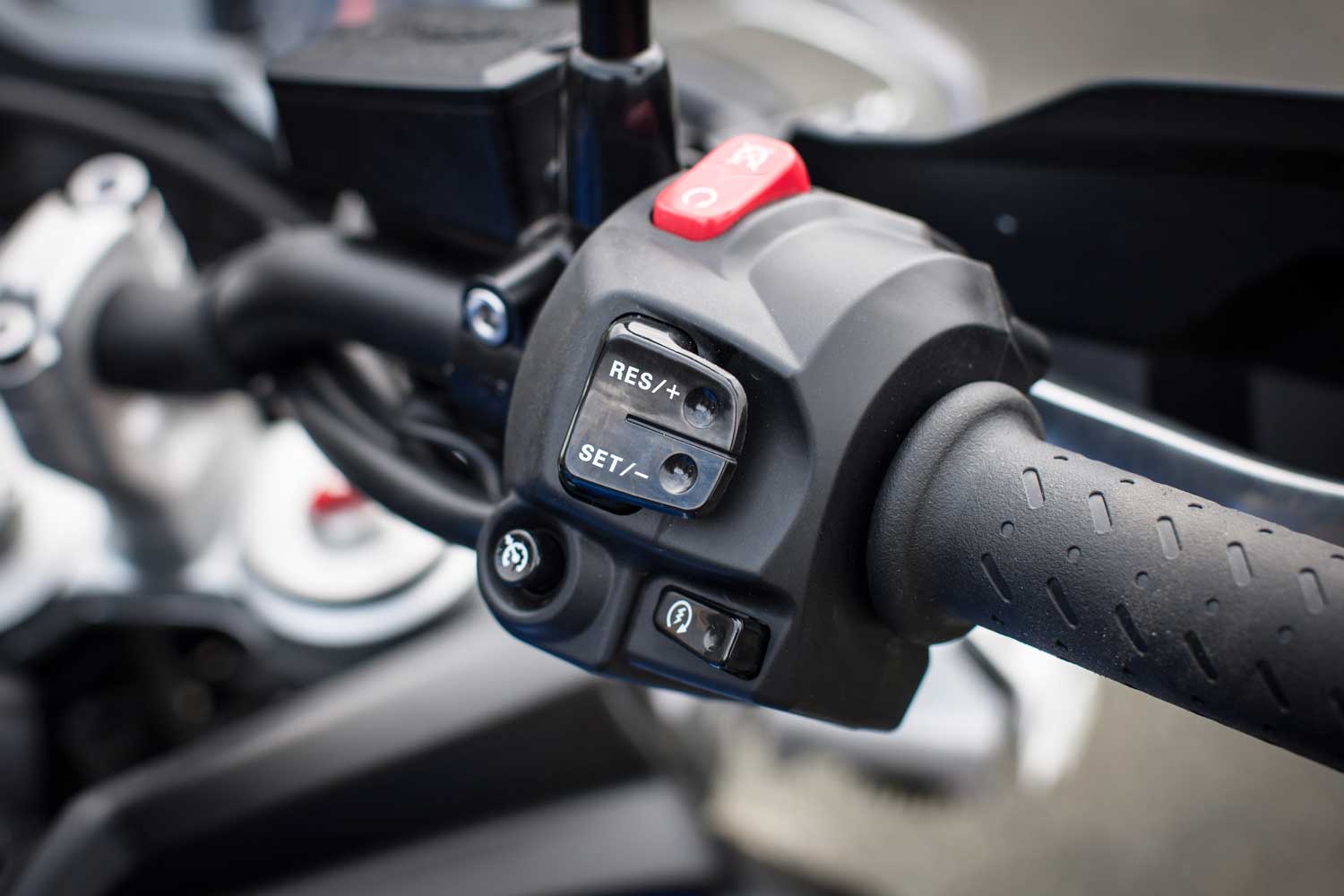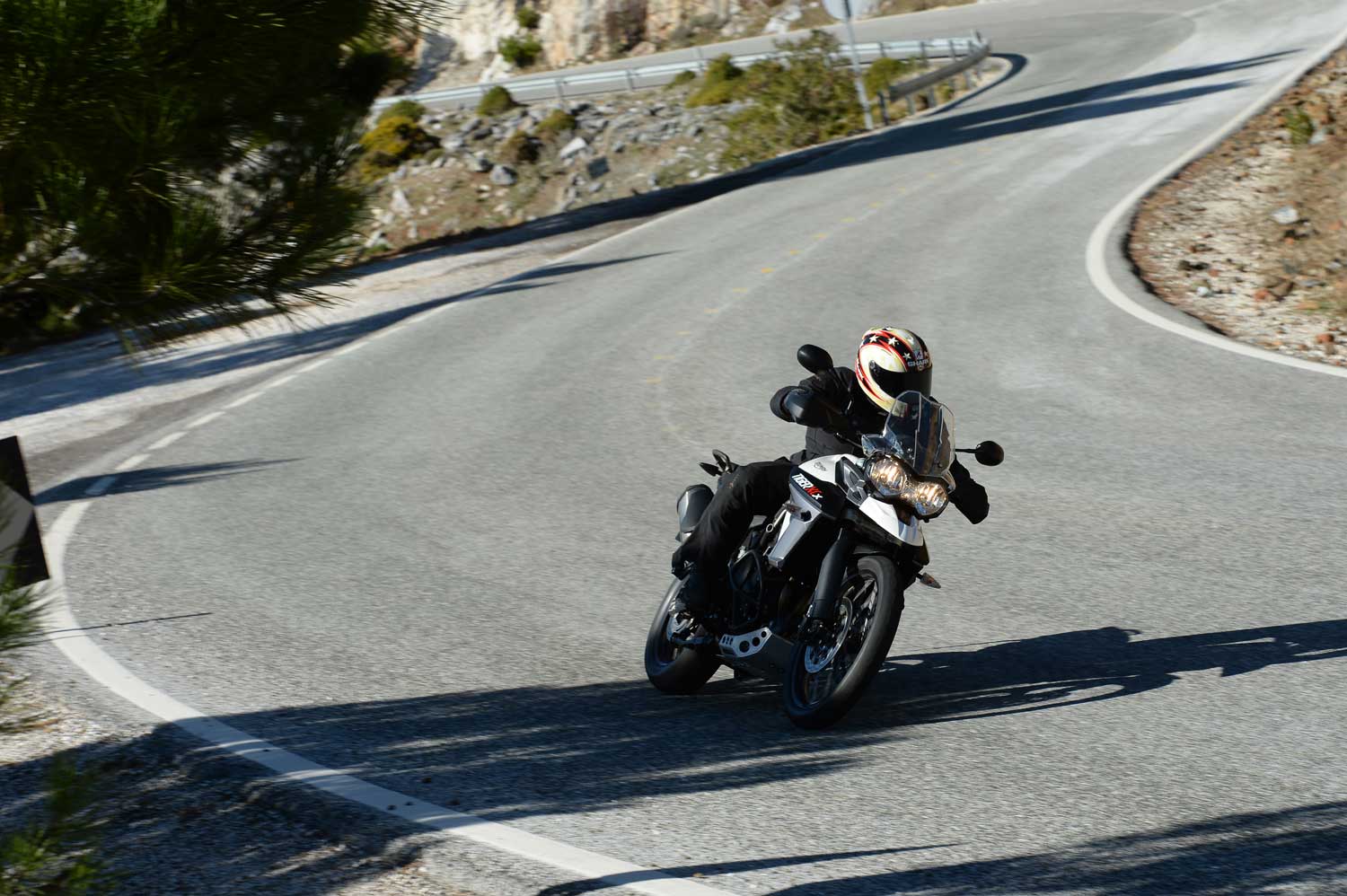2015 Triumph Tiger 800 | From £8499 | 94bhp@9,250rpm |58lb-ft@7,850rpm | 800cc liquid-cooled, line 3-cylinder
Tested by: Tony Carter Photos by: Alessio Barbanti, Paul Barshon, Matteo Cavadini, Freddie Kirn
Despite what Triumph and anyone else will try to tell you, the Tiger 800 isn’t an adventure bike. It’s much more than that. It’s also not an update – 56 changes over the previous machine make this a new model in my book. The only thing that’s stayed the same is the frame. And the name. And two bolts that hold the screen in place.
Two models (plus ‘x’ variants) will be available in dealers from January – the road-biased XR and the more off-road orientated XC…
Tell me about the engine
The three-cylinder motor is quieter than the last model (launched in 2010), delivering the same 94bhp as before, but that peak now arrives at 9,250rpm (down from 9,300rpm). Torque is unchanged at 58lb-ft @ 7,570rpm.The bike feels more eager when you crack the throttle thanks to the new ride-by-wire system (so a lighter throttle action too). And the newly-used 675cc Daytona engine parts. And the new alternator, which has a 47% reduction in inertia.
Elsewhere in the new engine there’s a change to the cam profiles, increasing lift for more engine efficiency. In fact, Triumph claims that fuel consumption has improved by a huge 21%: on the semi-urban cycle defined by the United States FTP75 regulation, the new Tiger 800 delivered 58mpg. On the European GTR2 test cycle, economy improved by a still impressive 17% from 55mpg to 65mpg, meaning a potential range of up to 272 miles.
The company’s Daytona 675 gearbox parts give the bike sports-precision gear selection, and a smoother action during changes (Triumph also claims this to be a more reliable off-road set-up).
What’s the chassis like?
The tubular steel trellis frame is the same on the new Triumph Tiger 800 as on the previous bike, but it now gets a “Titanium” coloured powder-coated finish. The road-targetted XR gets Showa 43mm upside-down forks, with 180mm travel, while the XC carries fully-adjustable WP 43mm upside-down forks with 220mm of travel. The rear sees the same brand swaps, with the off-road aspirations of the XC gaining 215mm of rear wheel travel, compared to the XR’s 170mm. The Showa unit is adjustable hydraulically for preload, while the WP can be tweaked for compression and rebound damping, as well as preload.
Both bike have twin 308mm floating discs up front, gripped by Nissin 2-pot calipers with switchable ABS. The bars have been moved for more control at low speeds and to give the rider more room; on the XR they’re 5.5mm forward, 18mm up and are 2mm per side wider. On the XC they’re 0.7mm forward and 14.5mm up. Both bikes allow you to adjust the bars backwards and forwards by up to 20mm.
The seat (with 2.75 litres of storage underneath it) can be set between 810 and 830mm on the XR, with the XC offering 840 to 860mm. There’s also 10mm less footrest rubber for more leg room.
Should I buy one?
Yes, you should. The real question is which one it should be. The XC gives a more refined feel, and I reckon is the bike to go for if you want to explore a bit more – off-road the electronics really calm things down without getting in the way, so you an go green-laning should you fancy it. The XR is refined on the road and useable at 2mph or 120mph without problem. Both bikes have cruise control (a revised version of that fitted to the Triumph Explorer 1200)
The XRx and XCx gain three ride settings: “Road”, “Off-road” and “Rider”. Road and Off-road re-configure the bike for different surfaces via pre-set options, while “Rider” allows the user to fine-tune the set-up to suit their tastes exactly.
The new ride-by-wire (no mechanical connection between the twist-grip and the throttle bodies) looks after the traction control and all the clever stuff, but also gives a very light and precise throttle action.
So what’s it like to ride?
Our test route in Spain took us past massive, solid, orangey-hued slabs of purest geology to the right of the road. All jutting out, and aggressively stabbing you in the fear gland. On the left was a perfunctory Armco-type barrier that could maybe stop a runaway shopping cart allowed to roll down the hill for a few feet. Maybe.
The drop off the edge of the road was anything up to a couple of hundred feet. Yet the XR’s suspension, ABS and traction control made it fun, not terrifying. The electronics are easy to access and couldn’t be faulted; not once did the systems even appear on my radar whilst I was riding as hard as I could. But I know they were working away because at high speed on the Ronda road – with the bike leant over in fourth gear – I deliberately grabbed a handful of throttle. The little orange light on the instrument panel flashed away to tell me that various clever electronic goblins were saving my skin from a high-side, and I just carried on with riding as if all that smoothness was down to me. It wasn’t.
The power is wonderfully linear all the way from 4,000 up to just past 9,000rpm but it’s fun to let the motor spin on and stutter on the 10,000rpm redline – if only for the howl from the Hinkley triple.
It’s obvious there’s more room on the saddle. I’m 5’ 8” with a 28” inside leg, and the changes to the seat, footrest and handlebar position mean that on standard settings the 800 actually feels roomier than its 1200cc stable mate; the Explorer. Two days on the bike were a doddle, without the need to stretch a leg once. The seat is excellent and the tank lets you get a good grip with the knees when you up the pace.
The brakes are fantastic. The Showa suspension on the XR isn’t quite as sophisticated or luxurious as the simply gorgeous WP units on the XC, but on the road the XC’s set-up does take a beat longer to settle into a hard corner compared to the XR, which is worth noting. I like the WP units but the Showa’s simple arrangement just has the edge if – like most of us – you’re a more road-biased a rider.
The dash is easy to read and typical Triumph fare, with digital readouts and tacho dial. The handguards are terrific, but the screen is useless in stock trim. Fortunately, the larger aftermarket one is among the best I’ve ever used.
The fuelling is spot-on, the sound from the motor intoxicating and the overall look of the bike wouldn’t be out of place in either a Welsh enduro or a jaunt through Kensington High Street. This isn’t an Adventure bike. It’s much more than that. It’s a tick-list of everything you could want from a motorcycle and then some. I can’t think of anyone who wouldn’t enjoy the new Triumph Tiger 800 in any of its forms. Try one.
Tech Spec
Price: 800XR £8,499, 800XRx £8,999, 800XC £9,499, 800XCx £9,999
Engine: Liquid-cooled, 12-valve, DOHC, in-line 3-cylinder, 800cc
Power: 94bhp (69kW)@9,250rpm
Torque: 58 lb-ft (79Nm)@7,850rpm
Kerb weight: 213kg (XR); 218kg(XC)
Seat height: 810mm-830mm (840mm – 860mm)
Tank size: 19 litre
The new Triumph Tiger 800’s changes for 2015:
- Ride-By-Wire throttle
- Better engine efficiency
- Reduced emissions and engine noise
- 21% better mpg on urban riding (17% better mpg on mixed riding)
- Daytona 675 parts used for sports precision-like gear selection
- New tank side panels and radiator cowls for imposing look plus extra engine heat dispersion
- New symbols, decals and colours
- Refined seat with new stitch details
- New tapered black handlebar with change in grip position
- New silencer heat shield
- New heel guards
- -10mm footrest rubber for more rider leg room
- Longer chain guard (+90mm) to prevent spray onto the rear of the bike
- New chain rubbing strip to reduce chain noise when riding off-road
- 43mm WP USD forks adjustable for rebound and compression damping with clickers for Tiger XC
- WP monoshock with remote reservoir and dirt protector, adjustable for preload and rebound damping for Tiger XC
- Front brake pads with insulation to resist fade
- ABS and Triumph Traction Control as standard
- New switch cubes to control the instruments from the handlebars
- New instruments with two trips for Journey Distance, clock, air temperature, fuel gauge, gear indicator and analogue tachometer, odometer, ambient temperature
- Hazard button is now on the instruments
Differences between the XR and the XC models:
Tiger XR: Showa 43mm USD forks
Tiger XC: WP 43mm USD forks with adjustable rebound and compression damping)
Tiger XR: Showa monoshock with hydraulically adjustable preload
Tiger XC: WP monoshock with remote oil reservoir, hydraulically adjustable preload and rebound damping
Tiger XR: Cast aluminium wheels
Tiger XC: Spoke wheels
Tiger XR: 19” front wheels – ready for TPMS sensor
Tiger XC: 21” front wheels
Tiger XR: 810/830mm seat height
Tiger XC: 840/860mm seat height
Tiger XR: 213kg kerb weight
Tiger XC: 218kg kerb weight
Tiger XR also gains aplastic radiator guard as standard and high level front mudguard
New Triumph Tiger 800 XRx additions…
- 3 rider modes; Road, Off-road and Rider (2 modes on the XR; Road and Off-road)
- Cruise control
- Extended instrumentation; Trip Info (Journey Time, Average Speed, Consumption), Cruise Set Speed, Ride Modes, Range To Empty, Instantaneous Fuel Consumption, Self Cancelling Indicators
- Additional Power Socket
- Adjustable Screen
- Centre Stand
- Comfort Rider and Passenger Seat
- New Hand Guards with improved protection
New Triumph Tiger 800 XCx additions…
- 3 rider modes; Road, Off-road and Rider (2 modes on the XC; Road and Off-road)
- Cruise control
- Extended instrumentation; Trip Info (Journey Time, Average Speed, Consumption), Cruise Set Speed, Ride Modes, Range To Empty, Instantaneous Fuel Consumption, Self Cancelling Indicators
- Additional Power Socket
- Centre Stand
- New Hand Guards with improved protection
- Engine protection bars
- Aluminium sump guard

